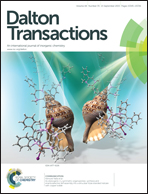A hydrothermally stable Zn(ii)-based metal–organic framework: structural modulation and gas adsorption†
Abstract
By the solvothermal reaction of a triangular ligand, 2,4,6-tris-(4-carboxyphenoxy)-1,3,5-triazine (H3tcpt) with Zn(NO3)2·6H2O in N,N′-dimethylacetamide/acetonitrile/H2O (v/v/v = 1 : 1 : 1) mixed solvents, a two-fold, interpenetrated, three-dimensional (3D), porous metal–organic framework, [Zn2(tcpt)OH]·solvents (1·solvents), with a rare, paddlewheel secondary building unit (SBU), Zn2(COO)3, was synthesized and characterized. It was found that a single 3D structure of 1 forms when two-dimensional layers, which are constructed by tcpt3− bonding with the paddlewheel SBUs, are linked by –OH groups along the axial sites of the SBUs. Compared with the reported Zn(II)-based partners with this ligand, synthesis conditions, particularly the solvents used, clearly played a key role in the formation of different SBUs, thereby resulting in distinct MOFs with the same ligand. In particular, 1 features good water and thermal stability and can withstand acidic aqueous solutions with pH values ranging from 5 to 12. In addition, 1 displays good adsorption ability towards H2 (2.21 wt% at 77 K and 1 atm) and can selectively adsorb CO2 from CH4 and N2, in spite of its relatively low void volume (36.8%), suggesting potential applications in gas storage and separation.


 Please wait while we load your content...
Please wait while we load your content...